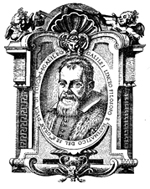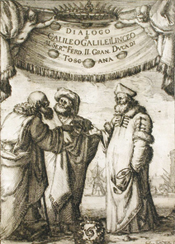Gallery: Ellis Paul
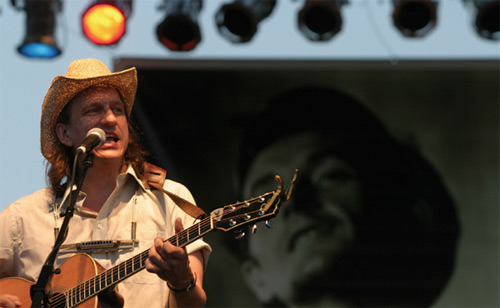 |
Ellis Paul performs annually at the Woody Guthrie Folk Festival in Okemah, Oklahoma, birthplace of Guthrie, who was also a frequent opponent of orthodoxy. Paul also performed at Guthrie's posthumous induction into the Rock-and-Roll Hall of Fame in 1996. Photo courtesy of Ellis Paul |
|
|
| Portrait of Galileo, The Assayer (1623). |
'Did Galileo Pray?'
The sighting of Jupiter's moons by Galileo Galilei resonates through science and history. Using a handmade telescope in January 1610, Galileo confirmed the Copernican theory that the planets moved around the sun; the Earth was not the center of the solar system. Galileo verified a new truth, and threatened the orthodoxy of his time.
Nearly four centuries later, while NASA's Galileo mission was beaming back close-ups of Jupiter's moons, folk musician and songwriter Ellis Paul began reading about astronomy. With a newly-purchased telescope, he gazed into the clear night sky above Boston in January 1998. He rediscovered Galileo's new truth, and did what a songwriter does.
Writing "Did Galileo Pray?" Paul envisioned the inner conflict: Could Galileo embrace both science and faith? Could he continue to pray? After releasing the song, Paul received an invitation from the renowned History of Science Collections of the University of Oklahoma Libraries. "The curator brought me in because of the song," Paul says. "She showed me one of Galileo's original manuscripts of the Dialogue. She handed the book to me. It was the original edition, Galileo's copy of the book. I was holding it. He had written his name on the book... I saw his notes, his crossouts. It was completely mind-boggling."
Paul links Galileo with civil rights marchers in the 1960s, and the student stopping a tank in Tian'anmen Square in 1988. "I picture that student stepping in front of the tank as a way of really going head-to-head, of putting his life on the line for change and understanding and truth," Paul says. "Galileo went before the tanks of his day–the Catholic Church. Martin Luther King went before the racists, and a few hundred years of American history, by stepping right to the front of that line marching in Birmingham. I celebrate those people who confront the old way, who take that bold step, going head-to-head."
Paul admits his lyrics are slightly off-target: "Did he know... a prison cell / Would be where he'd lay his head down?" Galileo's sentence of life imprisonment for disobeying the Church was commuted to house arrest. Paul remembers his chagrin during one performance: "Some Columbia University students sat there shaking their heads at me." But scientists are still going head-to-head with society over stem cell research, global warming, and even evolutionary biology.
"The truth is in front of us all the time, that's the thing that's amazing to me," Paul says. "The mathematics was there, the sky was there. It was just a matter of time before the truth came out through Galileo. The world was enlightened, but it took the Catholic Church until 1992 to forgive Galileo. That's how the planet works, it seems. The truth gets in front of people, it gets too obvious to ignore, it beats people over the head, and still it takes some braver soul to be the poster child for the truth. There aren't many like that through history. But Galileo, Martin Luther King, the student at Tian'anmen–they're in that heroic vein."
Mike Perricone
|
|
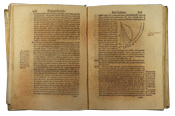 |
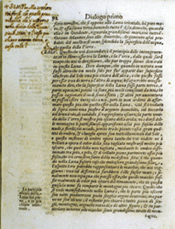 |
| Top image: Dialogue on the Two Chief World Systems (1632). Aristotle and Ptolemy (left) hold an Earth-centered armillary sphere. Copernicus (right), holds a Sun-centered model of the solar system. |
| Middle image: In the Oklahoma Dialogue, the annotation in Galileo's handwriting on the right page says the figure about falling bodies is upside down. |
|
Bottom image: This page shows a new sentence by Simplicio to go before a long paragraph by Salviati, again written by Galileo. |
|
All Galileo images copyright History of Science Collections, University of Oklahoma Libraries. Used with permissio |
Did Galileo Pray?
by Ellis Paul
When he looked
Into a starry sky upon Jupiter,
With its cold moons
Making their weary rounds.
Did he know that the Pope
Would claim that he ran with Lucifer
And a prison cell
Would be where he'd lay his head down?
Was he wearing a thorny crown?
When he plotted the motion of planets,
Was Mercury in retrograde?
But he found the truth when a lie was what was demanded.
When the judges asked him pointedly
He was a' trembling that day.
Chorus
Did Galileo pray?
Did Galileo pray?
Did Galileo pray?
Did Galileo pray?
And he said,
Tell Ptolemy, tell Copernicus,
That the Sun is at the core of us
The Church, the Pope
Can't deny the Milky Way
And every flower that follows the sun,
Has known all along
What God had done
They whisper truth
As the seasons each give way.
Don't shoot the messenger,
The postman delivers Truth today.
And Truth will march in Birmingham
It will block the tanks in Tiananmen.
Put the judges on the witness stand
Let's see what they all say.
Chorus
In the heavens you'll see it
As God has conceived it.
Oh, believe it.
Oh, what have you got to do to believe?
Don't shoot the messenger,
When the postman brings you truth today.
Because truth will march in Birmingham
It will block the tanks in Tiananmen
Put the judges on the witness stand,
Let's see what they all say.
Chorus
Don't shoot the messenger, don't shoot the messenger...
Copyright Ellis Paul Music (SESAC) 2000. Reprinted with permission.
Click here to download the pdf version of this article.



